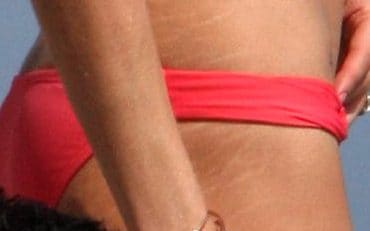The Truth is That Stretch Marks Are Not Inevitable
Stretch marks can be really harmful to yourself esteem, especially if they’re on show to the world. With Summer round the corner it’s time to look at how to remove those stretch marks, but before we do that we have to understand what exactly stretch marks are.
What are Stretch Marks?

Stretch marks are very simply where your body has had to adapt to a sudden change. As you’ve grown your skin has grown too, so when you grow rapidly it doesn’t allow your skin time to adapt and grow too. This means it is put under stress and stretches, damaging the collagen in the layers of skin tissue and exposing the blood vessels underneath. These damaged blood vessels are what create the scar like streaks in your skin.
Typically stretch marks occur on the back, upper thighs, buttocks and abdomen and they occur in men, women and children. New stretch marks are red or purple, but over time they become white or silver, fading more into your skin.
What Causes Stretch Marks?
There are a number of reasons for stretch marks which include genetic disposition to them and hormone levels. Other common causes include growth spurts (particularly in younger children), weight gain, pregnancy and body building.
Each of these puts undue stress on your body and your skin, causing it to stretch to cope with the changes. The one thing that all types have in common is that everyone wants to know how to remove stretch marks.
Removing Stretch Marks
Stretch marks are difficult to full remove, especially the white marks that have been around for a long time. If you’re looking to fully remove them you’ll need to use one of two options:
-
Laser Treatment
A Pulse Dye Treatment has been developed to help cure stretch marks. The intense light beam targets the blood vessels without impacting or damaging the skin. The light then heats the specific area and dissipates the blood vessels, causing a fading of the red and a return to the normal colour.
This laser treatment is advanced but can be slow, and therefore expensive. It’s not suitable for anyone who is pregnant, breastfeeding or have specific skin conditions. For those with darker skin or stretch marks around the legs the treatment will be less effective because the laser cannot penetrate as well.
Side effects are minimal, you may experience some redness or light bruising in the area.
-
Surgery
Surgery can be used to replace damaged skin with stretch marks. This is expensive and drastic and can have side effects. You’ll need to talk to professionals and your dermatologist before you consider this option.
Stretch Mark Treatments
There are a number of treatments available both at home and over the counter that won’t remove stretch marks but may aid in their reduction. Popular home remedies include:
- Sugar Scrub
- Castor Oil
- Lemon Juice
- Egg Whites
- Coconut Oil
While each of these have been shown to benefit your skin generally, there is little or no evidence that they will have a specific impact on your stretch marks.
Over the counter medicines and topical treatments include:
- Tretinoin
- Vitamin A Oil
- TriLastin-SR
Both of these are derived from retinol and designed to be applied directly to stretch marks. This can be absorbed by the skin and aids in the repair and growth of new layers of skin.
New Treatments for Stretch Marks
The skin care industry is constantly changing and creating new solutions to the problems affecting individuals. With stretch marks affecting over 80% of women and up to 40% of men It’s a big problem. There’s rumors of a new laser procedure being created as a simpler and more effective treatment, but always consult with your dermatologist for all the latest information.



